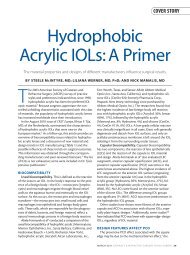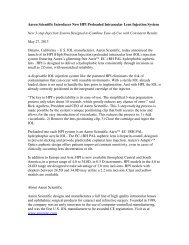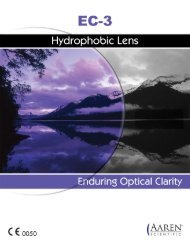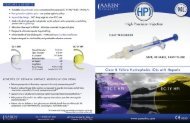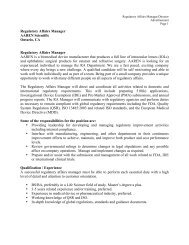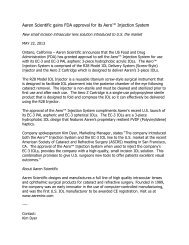Aaren Scientific's
Aaren Scientific's
Aaren Scientific's
Create successful ePaper yourself
Turn your PDF publications into a flip-book with our unique Google optimized e-Paper software.
Optic Design<br />
Multifocal (hybrid with refractive and diffractive<br />
properties) aspheric biconvex*<br />
Optic Material<br />
Hydrophilic<br />
Optic Diameter<br />
6.0 mm<br />
Overall Diameter 11.0 mm<br />
AC Depth**<br />
5.1 mm<br />
A-Constant**<br />
118.1 mm<br />
Angulation 5°<br />
Refraction Index 1.46<br />
Minimum Incision Size 2.2 mm<br />
Diopter Range<br />
10.0 to 30.0 D (in 0.5 diopter increments)<br />
* Multifocal surface is placed posteriorly. Refractive zone of progressive power occupies central 1.5 mm diameter<br />
and provides far and intermediate foci. Diffractive zone occupies area between 1.5 mm and 3.8 mm diameters<br />
and provides far and near foci. Bi-sign aspheric is formed by the base surface of the diffractive zone and the<br />
lens periphery outside 3.8 mm diameter.<br />
** A-Constant and AC-Depth are estimated for mid-range diopter power, and not based on clinical data. Values are<br />
dependent on diopter and determined by formula.<br />
Reduction of “Chair Time”<br />
Predictable vision makes for more satisfied patients and a lessening of surgeons’ concerns. Simplify<br />
lens choice for surgical operations (no mixing or matching needed), and enhance all-condition<br />
vision quality with OptiVis - a fully feature-integrated, benefit-balanced, easy-to-use, state-of-the-art<br />
multifocal IOL.<br />
p/n 3829A<br />
The future of presbyopia -correcting IOLs is now.
Patented* RADIAM Optic<br />
Superior Contrast Sensitivity in Low Light Conditions<br />
A New Generation Diffractive-Refractive Multifocal IOL<br />
The current generation of multifocal diffractive IOLs provides predictable vision for Far and Near<br />
ranges. However, these lenses lack a predictable solution for not only the Intermediate range, but<br />
for Contrast Sensitivity and Dysphotopsia (halos) at low light conditions. OptiVis represents the<br />
next generation of multifocal diffractive optic, and is designed to offer true vision predictability and<br />
pupil independence. This unsurpassed optic design, coupled with manufacturing precision delivers<br />
exceptional clarity in patient’s daily lives.<br />
An Innovative Design for All Distances, All Lighting Conditions<br />
Nominal eye with spherical monofocal IOL.<br />
Retinal Image corresponding to 20/40 at<br />
5 mm pupil (best focus at 3 mm)<br />
Nominal eye with OptiVis. Retinal Image<br />
corresponding to 20/40 at 5 mm pupil<br />
(best focus at 3 mm)<br />
OptiVis offers the following features to help ensure predictable contrast sensitivity in low light conditions:<br />
• The unique bi-sign aspherization of OptiVis creates positive and negative ocular aberrations at large<br />
pupil diameters to not only balance out corneal aberrations, but also to compensate for ocular<br />
aberrations within the lens itself. This leads to superior image quality even with lens decentration and tilt.<br />
• OptiVis apodization increases Far image dominance with increasing pupil size to improve Far<br />
image contrast sensitivity in low light conditions.<br />
• With OptiVis, only a small percentage of light falls outside of the range of vision.<br />
OptiVis<br />
Competitor# 1<br />
Competitor# 2<br />
Competitor# 3<br />
Light Distribution Table<br />
Pupil Size Near Intermediate Far Outside range<br />
of vision<br />
2 mm 33% 38% 27% 2%<br />
5 mm 20% 6% 68% 6%<br />
2 mm 40% 0% 40% 20%<br />
5 mm 10% 0% 84% 6%<br />
2 mm 30% 0% 55% 15%<br />
5 mm 30% 0% 55% 15%<br />
2 mm 40% 0% 40% 20%<br />
5 mm 40% 0% 40% 20%<br />
<strong>Aaren</strong> Scientific’s next generation pseudo-accommodative multifocal, Optivis, provides intrinsic<br />
powers for Near, Intermediate and Far at a full range of pupil sizes leading to predictable Intermediate<br />
vision, in addition to Far and Near.<br />
Retinal Image of far bright object<br />
with halo at the eye with prior<br />
multifocal IOL design (simulation)<br />
Reduction of Dysphotopsia (Halos)<br />
Several of OptiVis design features also reduce Dysphotopsia:<br />
• Unique apodization to minimize halo size. (The area of the lens that passes most of the light to Near<br />
focus is located close to the center of the optic.)<br />
• Bi-sign aspherization to maximize Far contrast, even with lens misalignment.<br />
• Small percentage of light falls outside of the range of vision.<br />
Retinal Image of far bright object<br />
at the eye with OptiVis results in<br />
minimized halo (simulation)<br />
*US Patent No 7,073,906



